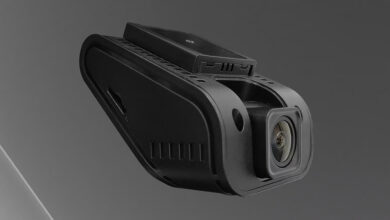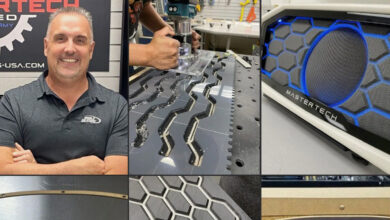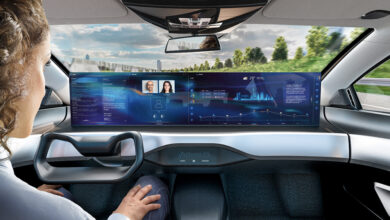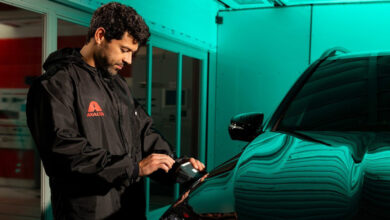As Vehicle Tech Advances, the Importance of Vehicle Coatings Grows
Automotive coatings will need to provide far more than eye-catching aesthetics and extended protection when an array of new mobility models enters the market, according to Rebecca Liebert, PPG senior vice president of automotive OEM coatings. Libert shared her thoughts during a live panel discussion-titled The Road Ahead: Examining the Impact of Autonomy Beyond the Vehicle-at an Automobili-D presentation at Detroit’s Cobo Center.
Liebert said PPG researchers are developing coatings that will enable reliable autonomous vehicle operation, enhance the performance of electric-vehicle battery packs and improve passenger comfort and utility.
As one example, coatings are being developed to reduce absorbance and increase reflectance of LiDAR and radar wavelengths emitted by autonomous driving systems. Without these, a darker-colored vehicle, bridge abutment or other obstacle can be significantly less visible to LiDAR and radar systems. Additionally, the performance LiDAR sensors can be affected by dirt, road spray and other potential obstructions.
“A vehicle’s ability to sense and react to its driving environment is the central focus for safe, reliable autonomous operation, and functional coatings can help OEMs address this need,” Liebert said.
Liebert also described a variety of PPG coating technologies that can interact with traffic systems and provide identification of roadways, signs, tunnels, buildings and other infrastructure.
Modern coatings are already playing power storage and protective roles in lithium-ion battery packs. Liebert said PPG has developed a new battery coating that is more environmentally friendly than many existing solutions and provides improved battery range and performance.
“In many cases, we have the advantage of being able to leverage PPG research and market-ready technologies that are already benefitting our customers in other industries, including aerospace,” she said. “This ability to quickly adapt and validate existing solutions for new challenges helps set us apart in the mobility space.”
Future of Color
Color is becoming an increasingly valuable tool in the battle to connect with modern automotive manufacturers and consumers, including those attracted to new mobility models such as autonomous driving and shared vehicles, according to the color experts at PPG.
PPG is helping global vehicle manufacturers apply sophisticated new color strategies to help enhance brand differentiation and address both the aesthetic and functional realities of vehicles that will be used in new ways.
“Vehicle OEMs and their customers are thinking about mobility in ways that accentuate the importance of color, texture and other design characteristics,” said Jane Harrington, PPG global manager of color styling and automotive OEM coatings. “From a marketing perspective, we’re seeing a shift toward a more holistic design aesthetic for vehicle interiors and exteriors, including sophisticated wheel coatings.”
To address this trend, PPG’s annual automotive color forecast now incorporates color collections for virtually all visible interior and exterior automotive surfaces, including body panels, doors, consoles, instrument panels and seating accents. Shared vehicles will place an even greater importance on interior colors and textures and offer an opportunity for OEMs to show differentiation and unique aesthetics, according to PPG.
“Brand differentiation is absolutely vital in today’s automotive industry, and we’re seeing OEMs approach this challenge in a much more comprehensive way,” Harrington said. “Their strategies can be seen not only in exterior color styling but also in a wide range of interior design choices, such as the use of high-gloss versus matte finishes or smooth versus textured surfaces. We believe it’s important to be able to help them achieve every design objective.
“Color and related coatings technologies also will help ease the transition to autonomous driving, shared mobility and other emerging technologies,” she added. “As technology in the car’s interior becomes increasingly important, providing options that enable brands to create surfaces that are user-friendly, easy to keep clean, and distinctive can enhance the overall brand offering.”
But don’t discount the importance of exterior color, which will remain a leading consideration for car buyers even in an age of autonomous and shared vehicles, Harrington said. While LiDAR (light detection and ranging) and radar systems used in autonomous vehicles traditionally couldn’t adequately detect darker-colored vehicles, PPG has developed an innovative coatings technology that enhances detection of a range of colors.
Of course, not all paint carries color. One leading trend in the age of modern mobility will be the use of transparent, functional coatings that enhance user comfort and utility. These include anti-fingerprint, anti-smudge and anti-glare coatings for touchscreen devices in shared vehicles.
“In these cases, we’re seeing a fusion of what a paint looks like and what it can do from a practical perspective within a given application,” Harrington said.



